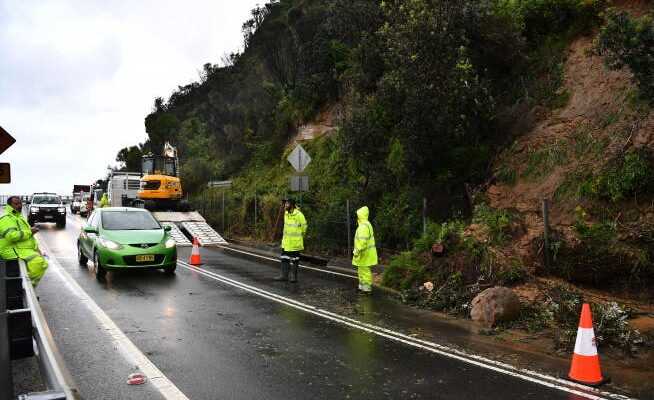The consequences of climate change can be clearly felt in Australia. So far, 2022 has been characterized by constant rain and flooding on the east coast.
Heavy rain has caused a landslide on a slope near Coalcliff south of Sydney.
(dpa)/dho.
There has almost never been so much rain in Sydney: just a month after the catastrophic floods on the Australian east coast, parts of the metropolis are again affected by heavy rain.
In just three months, as much precipitation fell in the city with the world-famous opera house as it usually does in a whole year, the 7News broadcaster quoted a spokesman for the Australian meteorological authority as saying on Thursday. The situation was particularly dangerous in the southern suburbs of Woronora and Bonnet Bay, where authorities issued evacuation orders for thousands of residents.
Days of heavy rain had already led to historic flooding in February and March, especially in the north of the state of New South Wales and in neighboring Queensland. In Sydney it had rained almost continuously for two and a half weeks. At that time, meteorologists were already talking about the wettest start of the year in the country’s largest city since weather records began in 1858.
Dangerous Sydney funnel web spider
The humidity has another unwelcome effect: “Australia’s notorious “creepy crawlies” (creepy crawlies) are out in droves and are looking for refuge from the unrelenting rain,” reported the broadcaster 9News, citing experts.
Numerous citizens reported a massive increase in leeches in social networks. But snakes and spiders are also on the rise, including the dangerous Sydney funnel-web spider – the world’s most venomous spider species. Since the development of an antidote in 1981, however, there has not been a single death that was clearly attributed to the spider.
Make sure you check for funnel web spiders with all this rain #yikes #SydneyWildlife #Sydney pic.twitter.com/E1QhQUTVWD
— ruthenium erbium ? (@RErbium) April 6, 2022
A Sydney resident has donated half a dozen funnel-web spiders to the Australian Reptile Park’s antivenom program in the past two months alone, said the park’s reptile keeper Sam Hermann.
This is a clear indication of the massive increase in sightings. But there is no reason to panic: the animals are not out to intentionally hurt people. It is best to stay calm and catch the animals safely – but also to have a compression bandage ready just in case.
Thousands of people will probably have to leave their homes for the third time
Meanwhile, there is no end in sight to the rain: Although it will subside over the weekend, new precipitation is expected from Tuesday, according to the weather service. “The ground is saturated with water, the rivers are full, the dams are at their limit,” said Dean Story of the New South Wales State Emergency Services. The authorities also warned of possible landslides because of the unstable ground.
⛈Severe Weather Warning⛈ for HEAVY RAINFALL in Metropolitan, Illawarra, South Coast and parts of Hunter, Central Tablelands & Southern Tablelands.
⚠Areas of heavy rainfall over southern and central NSW.
For more details, please visit the @BOM_NSW https://t.co/dkeyF4lfCR pic.twitter.com/XVjW7wwH4b— NSW SES (@NSWSES) April 7, 2022
So now tens of thousands of people could have to leave their homes for the third time in a month. A month ago there were already around 40,000 people in the suburbs of Sydney. The big problem is that the water can go from ankle deep to shoulder high in a matter of minutes.
So far, people seem to be heeding the government’s warnings. A spokeswoman told the Sydney Morning Herald that there have been relatively few rescue operations compared to requests for help.
The public transport network was still hampered by the rain on Thursday. In many places, train traffic had to be stopped due to flooding. Transport Secretary David Elliott said the government was working to restore the regular timetable.
